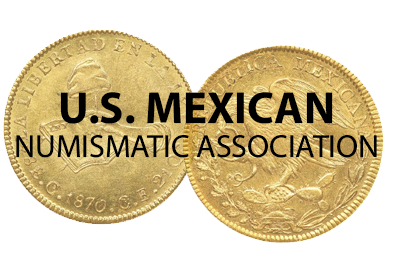A closer look at the Oaxaca one centavo series
by Greg Meyer (in collaboration with Mike Dunigan)
Just as Covid was starting in early 2020, a Oaxaca 1872 centavo came up on eBay along with one from 1873. Not having the funds to chase both, I made my best bid on the 1872 and ended up winning it. My conclusion was that it was not a very fine coin, had the usual environmental damage and it was now in my hand! The coin matched others I had seen that were in lower grade when I was working on the Republic One Centavo book over ten years ago. In 2022 I was contacted by a collector about the availability of the rare dates. He was looking to complete as much of the series as possible. We met at the 10th USMexNA convention. I showed the 1872 Oaxaca cent (it is the third die pairing documented in this article) and it inspired some competitive spirit in the group. Of course, only one person at a time can own or be the custodian of a coin and the coin changed hands. Quite a few questions arose because the Oaxaca centavo was produced for only four years per official records. Its production is documented by Buttrey and Hubbard in their book, A guide book of Mexican Coins 1822 to date as below. While Buttrey and Hubbard were unaware of the existence of the 1876, I have added it to the list with the population of extant examples known to me.
| Year | Mintage | Extant number seen at auction or in collections by the author |
| 1872 | 15,724 | 20 |
| 1873 | 10,787 | 12 |
| 1874 | 4,835 | 4 |
| 1875 | 2,860 | 0 (Produced in 1876, see discussion further below) |
| 1876 | - | 2 |
For a copper coin meant to be used in commerce, the production at the Oaxaca mint can best be described as ‘anaemic.’ Why such a low production? We will likely never know, but, as the mints were concessions from the government and run as profit making businesses, copper could have been considered a money loser in the less economically competitive areas of Mexico such as Oaxaca. Mintage seigniorage (government allowed profit) paid the bills and created wealth for the owner of the mint patronage. Any work done on coins that were fiat currency such as the centavo would be avoided, if possible. It is noted in Dunigan and Parker’s book on the Republic eight reales series, ResplandoresResplandores: Cap and Rays 8 Reales of the Republic of Mexico 1823-1897 by Mike Dunigan and J. B. Parker, Superior Stamp and Coin company, Beverly Hills CA.,1997, that the Oaxaca mint appears to have had two mint operations from 1861-1863. One of the mints had sub-standard equipment and the other better maintained and possibly better personnel. While this was nine years before the start of the Oaxaca centavo series, the equipment and personnel likely would have been still present as the Mexican decimalization effort started. The balance scale peso portion of decimalization did not go well and was discontinued by Mexico after 1873, mainly due to Asian resistance. To support inspection standards of the first Oaxacan centavo, higher quality strikes of the series were likely done with the start of production in 1872. Then, as the copper coinage was a money loser at such a low volume in Oaxaca, the mint owners cut costs by having the copper struck at the secondary mint, or, in the regular mint using the older sub-standard equipment and personnel.
The author wants to emphasize that commonly available Guadalajara centavos can easily be manipulated at the die mark to appear as a Oaxaca mint mark. There are a number of these that come up for sale mostly in private offers. The best way to determine if a Oaxaca centavo is real when worn is to look at the laurel leaves below the mint mark and on the right side of the wreath. The ones below the mint mark will be sharp pointed and many of the ones on the right side of the wreath will be pointed as well.
1872 Oaxaca Centavo
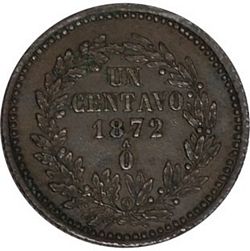
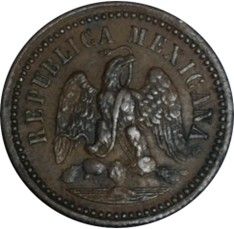
There are nicely struck higher grade coins for 1872: however, the following years see a significant deterioration in the dies used and in their execution. Within the production year of 1872 both the obverse and reverse dies required re- punching (see below for the obverse). The small A used in the mint mark is only seen for 1872. The remaining years all use a large A. Denomination and date alignment is perfect for some of 1872 and then quickly degrades. Variety three for 1872 (see below) was not included in the original Republic Centavo book because I had not then seen it in hand. Since then, the Krause 2019 Price guide uses the third die pairing of 1872 as its example of KM391.7 (the Oaxaca centavo series). Also the NGC website utilizes the third die pairing of 1872 as their Oaxaca centavo example.
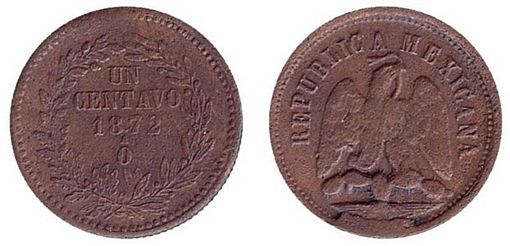
1873 Oaxaca Centavo
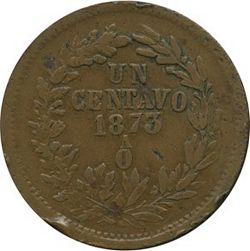
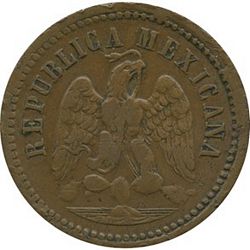
The diagnostics on this coin are the sharp pointed laurel leaves below the mint mark, the dropped O in CENTAVO and the small almost point-like denticles on the obverse and tiny denticles on the reverse. One can see the continuity of the degraded dies that started in the second die pairing of 1872 on the obverse, continued with the reverse degradation from 1872. Comparing the two varieties of 1873, note the straight ends of the legend of the eagle side die are similar to the second obverse of 1872. Also note that both the reverse above and below are from the same die, with a dropped O in centavo and the date angling up from left to right. Note the eagle side die below is in bad shape evidenced by the large die cud from 6 to 7 o’clock.

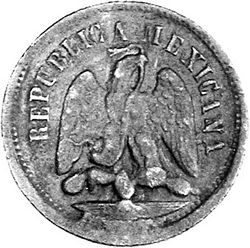
1873 Oaxaca Counterfeit
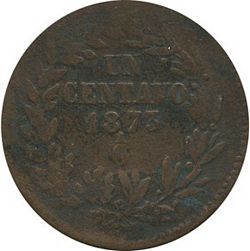
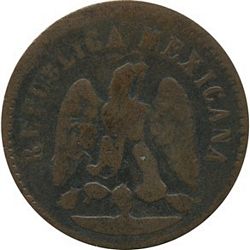
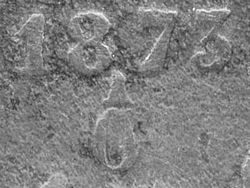 The 1873 Oaxaca has one outlier seen above. All other examples have the dropped and leaning O in CENTAVO and a date that angles up to the right documented at the beginning of this article. The outlier is pretty ‘normal’ in its details such as the CENTAVO letters are all even and the REPUBLICA MEXICANA legend is consistently round and not repunched. Another important ‘normal’ detail is that this example has rounded olive leaf tips, like the Guadalajara series and unlike the degraded die Oaxaca series. Although an exact match on the date placement for 1873 Guadalajara has not yet been found it seems that this example is an altered mint mark 1873 Guadalajara coin very similar to the 1875 discussed further below. Remains of the serifs from the Guadalajara mint mark can be seen in this enlarged and converted to grey tone picture right.
The 1873 Oaxaca has one outlier seen above. All other examples have the dropped and leaning O in CENTAVO and a date that angles up to the right documented at the beginning of this article. The outlier is pretty ‘normal’ in its details such as the CENTAVO letters are all even and the REPUBLICA MEXICANA legend is consistently round and not repunched. Another important ‘normal’ detail is that this example has rounded olive leaf tips, like the Guadalajara series and unlike the degraded die Oaxaca series. Although an exact match on the date placement for 1873 Guadalajara has not yet been found it seems that this example is an altered mint mark 1873 Guadalajara coin very similar to the 1875 discussed further below. Remains of the serifs from the Guadalajara mint mark can be seen in this enlarged and converted to grey tone picture right.
1874 Oaxaca Centavo
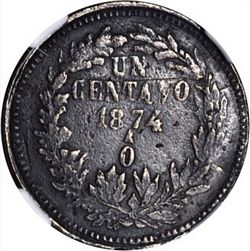
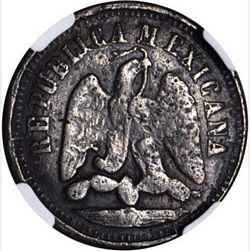
The olive leaves below the mint mark are sharp pointed in the example above and the denticles along the edge are bead-like. The dropped O in CENTAVO is now repunched higher than the V and the V is repunched wide to the rest of the denomination. The obverse eagle is well struck based on the REPUBLICA MEXICANA legend but devoid of any detail from its age and reuse. The legend itself is repunched, note the widely spaced M and the almost straight line of the CANA and RE.
1874 Oaxaca Counterfeit
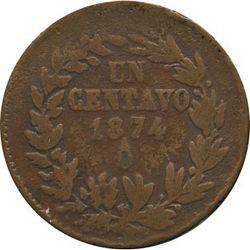
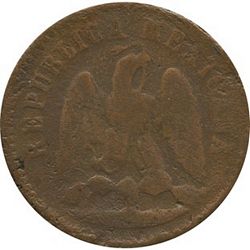
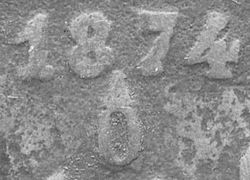 The olive leaves below the mint mark are rounded in the example above and the denticles along the edge are not beadlike. The O and V in CENTAVO are ‘normal’ for the series. The obverse eagle is well struck based on the REPUBLICA MEXICANA legend but devoid of any detail from its age and reuse. The legend is in the round and there are no indications of repunch straight line misalignments.
The olive leaves below the mint mark are rounded in the example above and the denticles along the edge are not beadlike. The O and V in CENTAVO are ‘normal’ for the series. The obverse eagle is well struck based on the REPUBLICA MEXICANA legend but devoid of any detail from its age and reuse. The legend is in the round and there are no indications of repunch straight line misalignments.
1875 Oaxaca, All Counterfeits
The 1875 Oaxaca counterfeit examples exhibit regular punching and have a good match with mint struck Guadalajara centavos such as the ones used in comparison above. It is likely that the 1875 Oaxaca examples that have these matching date configurations with Guadalajara are altered date specimens. The author asserts that there are no real 1875 Oaxaca centavos.
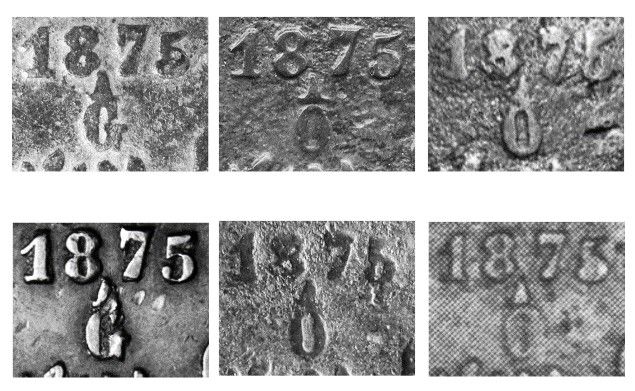
1876 Oaxaca Centavo
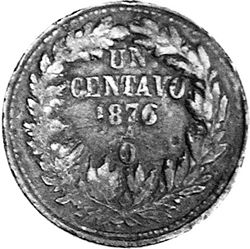
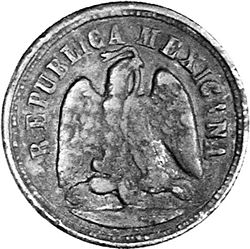
The 1876 Oaxaca has all the hallmarks of the Oaxaca centavo series identified in previous dates by this work and is accepted as genuine. The fiscal year is recorded in the Memoria de Hacienda tabulation books as from 1 July 1875 to 30 June 1876Memoria del ramo de la Hacienda Federal de los Estados Unidos Mexicanos, Mexico City, 1828. p.15 and Memoria de Hacienda del ano economica de 1877 a 1878, Mexico City, 1880. p.7 (the foldout tables typically have the fiscal dates observed for measuring production of an item, in this case it is silver from specific mines).. Mintages were reported based on production in a fiscal year. The officially documented ‘1875’ Oaxaca mintage could have easily occurred in the calendar year 1876 and the coins accordingly dated. An example of exactly this mismatch is seen with the 1870 Guanajuato 1 peso gold where Mike has watched for the supposedly existing date with none seen in his ongoing tenure as a collector and dealer of Mexican coins. He does see 1871 Guanajuato 1 peso gold examples even though no mintage is recorded for 1871. The fiscal year mismatch is apparent as documented by Dr. Pradeau in the third volume of his Historia Numismática de MéxicoHistoria Numismática de México de 1823 a 1950, by Alberto F. Pradeau, vol.3, Sociedad Numismatica de Mexico edition, Mexico City, 1861, p.168. The table for Guanajuato gold mintage of 1870-1871 documents 8 escudos and 20 pesos. The decimal gold was not produced until some time in December of 1870. The total for fiscal year 1870-1871 is 12,350 pieces. If the mintage was only going to be done for just a portion of a month before a new or modified die had to be made for the following year, it is likely the mint workers just went with a die for 1871.

The sequence of die pairings
Acknowledgements
Mike was key in providing the context of the fiscal year versus calendar year behind the 1876 Oaxaca centavo and allowing access to previously unknown specimens. Many thanks to the extended support network of our other Mexican coin friends in help reviewing this article. Any errors are our own and as we all know, new coins come to light over time and could well change this story yet again.
